Do you want to build a bigger and stronger back and improve your posture? The Don’t WORRY.
You don’t need a gym membership or expensive equipment to reach these goals. You can perform several back exercises at home without much or any equipment to help you build a strong and resilient back.
With home workouts, you don’t have to travel, wait for equipment, or stick to the gym’s hours. Bodyweight exercises also allow the joints to move naturally within their range of motion by creating more joint stability.
When you strengthen your back muscles, you can do better at sports and stay healthier. You also reduce the chance of getting hurt and feel better daily.
Here are 21 exercises for your back that you can do at home using your body weight and household items like bottles, dumbbells, and bands.

- 21 Best Back Exercises For Home Workouts
- Dumbbell Back Exercises At Home
- 1. One-arm dumbbell Row
- 2. Bent Over Dumbbell Lateral Raise
- 3. Dumbbell Deadlift
- 4. Dumbbell Floor Pullover
- 5. Dumbbell Shrug
- 6. Dumbbell Upright Row
- 7. Dumbbell Bent Over Row
- 8. Side-Lying Rear Fly
- 9. Seated Bent-Over Rear Delt Rows
- 10. Dumbbell Farmers Walk
- 11. Renegade Row
- Back Exercises Without Equipment
- 12. Superman
- 13. Good Morning
- 14. Hip Bridge
- 15. Flat Bench Hyperextension
- 16. Pull-Up
- 17. Inverted Row
- 18. Chin Up
- Back Workout At Home With The Resistance Band
- 19. Single Arm Resistance Bands Row
- 20. Resistance Bands Bent Over Rows
- 21. Seated Row with Resistance Bands
- At Home Back Workout Routine
- Training Plan As Per Your Goal
- Bodyweight Back Workout Routine
- At-Home Back Workout Without Equipment
- Back Workout Routine With Home Equipment
- FAQs
- Can I build a strong back without using weights or equipment?
- What are the best back exercises to do at home without equipment?
- How many times a week should I do back workouts at home?
- How long does it take to see results from back workouts at home?
- Takeaway
- Video On Best Back Exercises To Do At Home
21 Best Back Exercises For Home Workouts
If you don’t want to invest in dumbbells, you can use water bottles, steel and tin cans, bricks, bags, or any handy alternative that allows you to do the best back exercises at home.
There are many exercises you can do at home without any equipment.
We have created a back workout at home with many sections.
- Exercises for the back with dumbbells at home
- Bodyweight exercises for the back at home without equipment
- Back exercises with a resistance band.
If you’re a beginner, choose 3–4 exercises below and do 2-3 sets each, twice a week. Slowly, over the course of a few weeks, work your way up to 4 sets of each variety.
If you have experience, choose 4–6 of these exercises and do 3-4 sets each twice a week (or more).
Dumbbell Back Exercises At Home
A set of dumbbells at home allows you to perform back exercises without needing a gym or complex equipment.
Dumbbells offer a wide range of exercises that can be performed at home, providing versatility and variety in your back workouts.
To make your workouts more effective and interesting, you can do different exercises for your back, such as dumbbell rows, pullovers, bent-over lateral raises, and more.
1. One-arm dumbbell Row
If you’re looking for a straightforward dumbbell back exercise to add to your home workout routine, one-arm dumbbell row is a great staple exercise to get you started.
This good exercise works all the muscles in your upper back, including the lats, rhomboids, rear deltoids, and other muscles. You can do it at home easily.
This helps to work on each side independently, providing better muscle isolation and a longer range of motion.
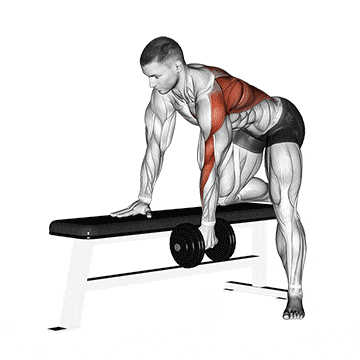
How To Do
- Grasp a dumbbell with the palm facing in.
- Put your other hand and knee on a bench and keep your spine straight.
- Raise the elbow as high as you can as you pull the dumbbell up alongside you.
- Pause at the top of the movement and squeeze your back muscles as you do it.
- Slowly lower the dumbbell as low as possible, feeling a good lats spread.
- Repeat on the other side.
Tips
- Keep motion under strict control for better isolation.
- Avoid hunchback bending as it leads to Injury.
- Choose a dumbbell weight that challenges you while allowing proper form and control.
2. Bent Over Dumbbell Lateral Raise
The bent-over dumbbell raise is another great home back workout that targets the posterior deltoid, trap, and rhomboid muscles. It is a must-do exercise for building complete upper back muscles.
It can be performed in a standing or seated position. I prefer the seated version, as it requires strict movement.
Some variations may be more appropriate for individuals with specific needs or limitations. For example, if you don’t have a bench, a standing reverse fly can be the best option.

How To Do
- Sit on the bench or chair with your feet firmly planted.
- Hold a dumbbell in each hand with your palms facing inward.
- Lean forward and let the dumbbells hang at arm’s length below your shoulders.
- Next, take a deep breath and lift the dumbbells to your sides, keeping your elbows slightly bent.
- Pause at the top of the movement and then slowly lower the dumbbells back down to the starting position.
Tips
- Your arms should be parallel to your shoulders.
- Keep strict form to isolate the rear delts.
- Keep your core engaged to avoid strain on your lower back.
3. Dumbbell Deadlift
The deadlift is the King of all exercises, and It is a powerful exercise designed to build an overall physique that uses more muscles than any other exercise.
The dumbbell deadlift is the best exercise for strengthening posterior chain muscles, including the back, erector spine, glutes, and hamstrings.
You can do the deadlift with a barbell or a set of dumbbells and even with household items if you don’t have weights, like Backpacks filled with books, canned goods and milk jugs filled with sand or rice.
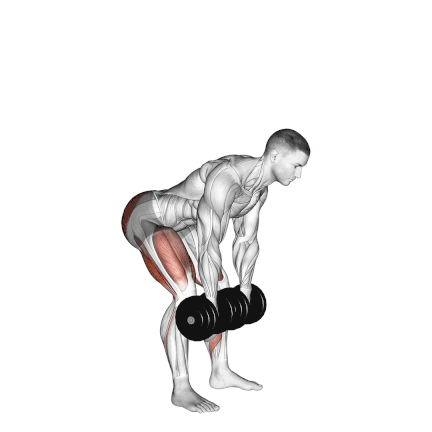
How To Do
- Place a dumbbell in front of you. Grab the dumbbells with each of your hands.
- Remember to keep your back as straight as possible and contract your back and hamstrings.
- Raise the dumbbell from the ground using your hamstrings and glutes.
- You should keep your legs slightly bent, your back straight, and your head looking up.
- Raise it to the point where your body is erect. Do not hyperextend your body as the weight shifts to the lumbar spine.
- Hold the dumbbell for a moment at the top of the lift.
- Now, lower the dumbbell slowly and steadily by bending at the hips and then at the knees.
- Let the weight almost touch the ground briefly before you begin the next rep.
Tips
- If performed incorrectly, the deadlift can cause more harm than good. Keep the back straight at all costs.
- The lower back muscles take a long time to recuperate; therefore, heavy deadlifts should only be done once a week.
- Go with the full range of motion and keep the form correct.
- Avoid jerky movements and keep motion controlled.
4. Dumbbell Floor Pullover
The dumbbell floor pullover is a good home exercise that works the chest, back, and shoulders muscles.
It involves lying flat on the floor and performing a pulling motion with a dumbbell, similar to a pullover movement.
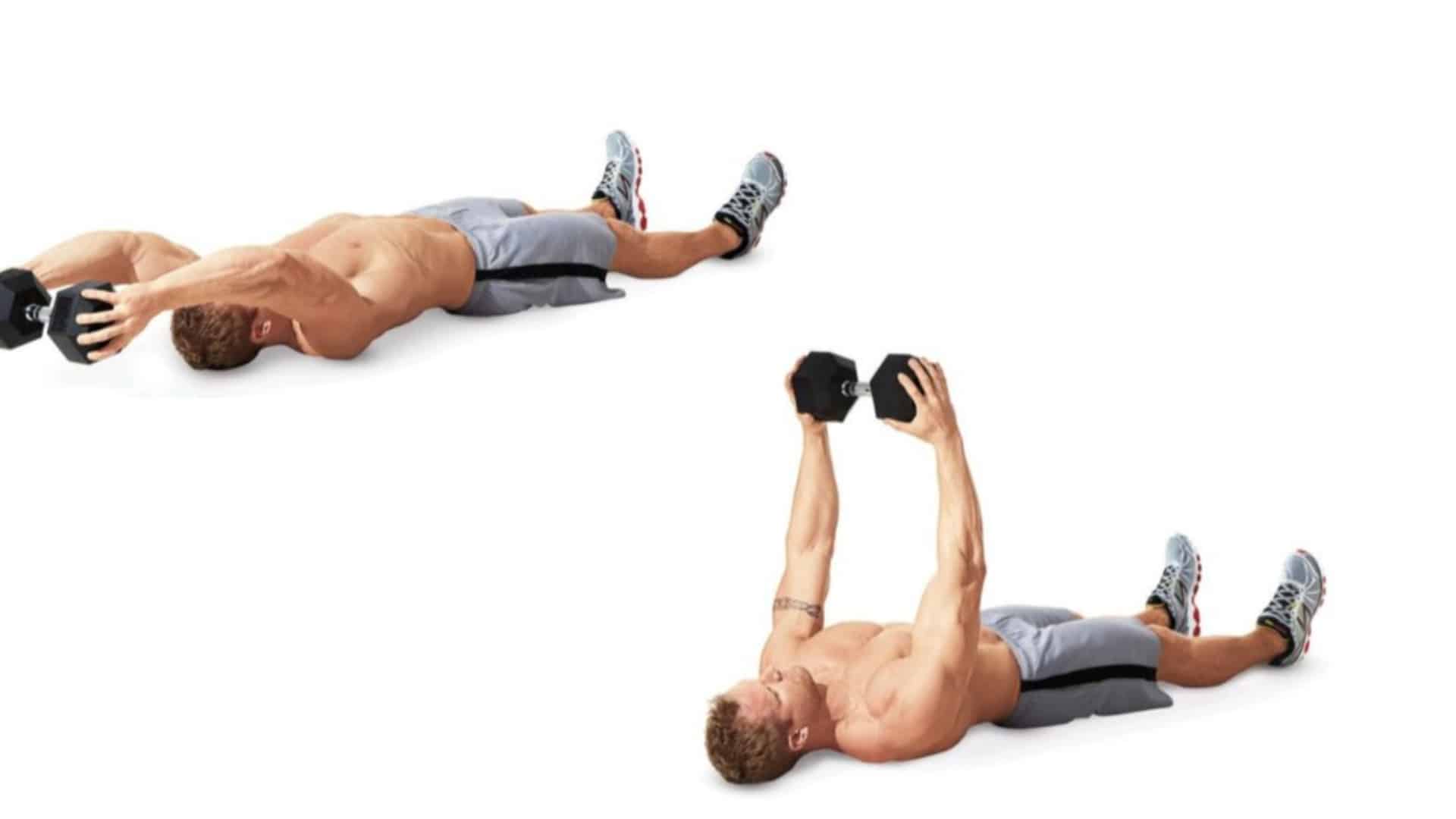
How To Do
- Lie flat on the floor with your knees bent and feet flat on the ground.
- Hold a dumbbell with both hands, gripping it vertically with your palms facing up.
- Keep a slight bend in the elbows as you extend your arms straight above your chest.
- Inhale and slowly lower the dumbbell in an arc slowly.
- Pause briefly when the dumbbell is parallel to the floor.
- Exhale and raise the dumbbell back to the starting position. Use your chest and back muscles to pull it up.
Tips
- Focus on a slow and controlled motion.
- Keep your neck relaxed and avoid straining or excessively arching your neck.
- Maximum stretching ensures the greatest expansion of the rib cage.
5. Dumbbell Shrug
The dumbbell shrug exercise is another great exercise to build bigger, stronger trapezius, upper back, and neck muscles.
If you don’t have dumbbells, you can still do shrugs with water jugs, canned goods, or other household items with a similar weight.
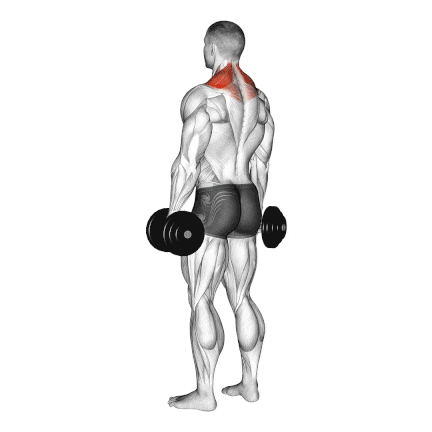
How To Do
- Stand with your feet shoulder-width apart.
- Hold a dumbbell in each hand with your arms extended by your sides.
- Keep your shoulders relaxed and your core engaged.
- Inhale and lift your shoulders towards your ears, making a shrugging motion.
- Hold the contraction for a second or two, then exhale and lower your shoulders to the starting position.
- Repeat the movement for the desired number of repetitions, typically 8-15 reps for 2-3 sets.
Tips
- Try not to move anything but your shoulders.
- Inhale when you lower the weight and exhale when you lift.
- Adding a pause at the top of the movement can help to enhance the mind-muscle connection.
- Don’t jerk or bounce the weight.
Related Post: Shrug Exercise: Benefits, Variations, Muscles Used, Tips
6. Dumbbell Upright Row
The Dumbbell Upright Row exercise is one of the best dumbbell exercises for the back that you can do during your upper body workout.
It is a compound exercise that targets your deltoids (shoulders) and traps (upper back) and biceps. It also activates the forearms for stabilization and support.
Using dumbbells in the upright row can help to increase unilateral muscle development and address any asymmetries and movement imbalances as well.
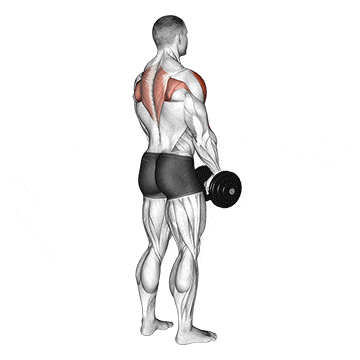
How To Do
- Stand tall with your feet shoulder-width apart.
- Hold a dumbbell in each hand with an overhand grip (palms facing your body).
- Let your arms hang down in front of you and slightly bend your elbows.
- Engage your core and maintain a neutral spine.
- Lift the dumbbell by pulling your elbows up and out to the sides, keeping them higher than your wrists.
- Keep moving until the dumbbells are at chest height or your elbows align with your shoulders.
- Then, slowly lower the dumbbells back down to the starting position.
Tips
- Remember to breathe out when you work hard.
- Keep the dumbbell close to your body.
- Keep a controlled motion and avoid jerky movements.
- You should keep your back straight.
Know More: Upright Row: Muscle Worked, How To Do And Form
7. Dumbbell Bent Over Row
If you want to strengthen the upper back at home and add massive muscle to the upper back region, then bent-over dumbbell rows are the exercise for you.
- Pulling the dumbbell higher toward the chest targets the upper latissimus and trapezius.
- Pulling the dumbbell through a lower trajectory to touch the abdomen targets the lower lats.
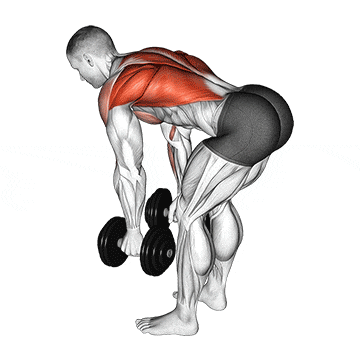
How To Do
- Stand with a narrow stance and a dumbbell with a neutral grip in each hand.
- Bend your torso forward at an angle of 45 degrees to the floor with your knees slightly bent.
- Now, use the back and raise the dumbbell until it touches the abdominal region and not the chest region, as it reduces back muscle contraction.
- Slowly lower the dumbbell, keeping it in control of the starting position.
Tips
- Do not use more weight than you can handle. Doing so fatigues your spinal erectors and says goodbye to form.
- Keep movement always under control without letting gravity take you down faster.
8. Side-Lying Rear Fly
When doing a back workout with a dumbbell at home, you can add plenty of single-arm exercises to correct potential imbalances.
Side-lying rear fly is a great unilateral exercise for targeting a smaller and often lagging muscle group. Instead of lying on the floor, you can lie on a bench.
This exercise targets the upper back muscles, particularly the rear deltoids.
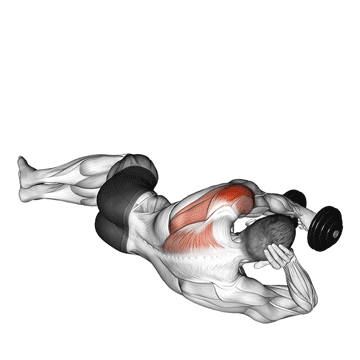
How To Do
- Lie on your side on a mat or a comfortable surface.
- Lie on the floor on your right side, and grasp the dumbbell with your left hand using a neutral grip (palm facing downward).
- Exhale as you raise the dumbbell from the floor until it is almost vertical. Hold for a count of two.
- Inhale as you reverse the movement and lower the dumbbell towards the starting position, stopping before the dumbbell touches the floor.
- Repeat for the desired number of repetitions. Repeat the exercise on the opposite side with your right arm.
Tips
- Do not allow the dumbbell to touch the floor.
- Keep the abs braced, and don’t arch the back at the top of the movement.
- Allow the arms to move freely, but don’t lock out the elbows.
9. Seated Bent-Over Rear Delt Rows
The seated rear delt row is an effective variation of rowing exercise that targets the muscles in the upper back and shoulders. Sitting on a bench eliminates any leg assistance and allows for a more isolated movement.
This exercise involves horizontal shoulder abduction and pulling the elbows behind the body.
It primarily targets the posterior deltoids and engages the upper back muscles, including the rhomboids and the trapezius muscles.

How To Do
- Sit on the edge of a bench or chair and put your feet flat on the ground.
- Hold a pair of dumbbells in an overhand grip and allow your arms to hang straight down in front of you.
- Bend forward at your hips, keeping your back flat and your core engaged.
- Lift the dumbbells up and out to the sides until your upper arms parallel the ground, with your elbows slightly bent.
- Squeeze your shoulder blades together at the top of the movement.
- Lower the dumbbells back down to the starting position.
Tips
- Keep your chest lifted, and avoid rounding your back.
- Make sure to use a weight that challenges you without compromising your form
10. Dumbbell Farmers Walk
The farmer’s walk exercise also called the farmer’s carry, is a strength and conditioning exercise in which you hold a heavy load in each hand while walking for a designated distance.
This exercise is a great way to build overall strength, grip, and core stability, all with minimal equipment.
You’ll need a clear indoor walking path of at least 20-30 feet (6-9 meters). If space is limited, you can turn around at each end and focus on maintaining a tight core and upright posture.
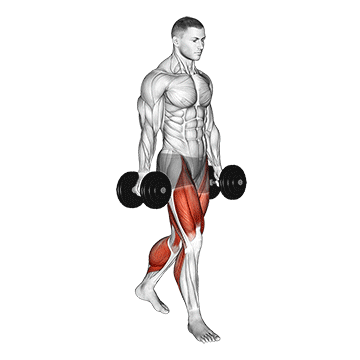
How To Do
- Pick up a dumbbell in each hand with a neutral grip (palms facing your body).
- Stand tall, keeping your shoulders, back, and core tight.
- Take small steps and walk forward at an even pace with your eyes focused straight ahead.
- Walk for your desired distance or time (30 seconds to 1 minute is a good starting point).
- 3–4 sets of 30–60 seconds walking or 20–30 meters per set
Tips
- Focus on squeezing your shoulder blades and tightening your abs.
- Keep a neutral or straight spine throughout the movement to avoid injury.
11. Renegade Row
The renegade row, also known as the plank row, is one of the top back workouts you can do at home with dumbbells.
The renegade row is a multitasking exercise that tones your back and works your core, while also testing your balance and stability.
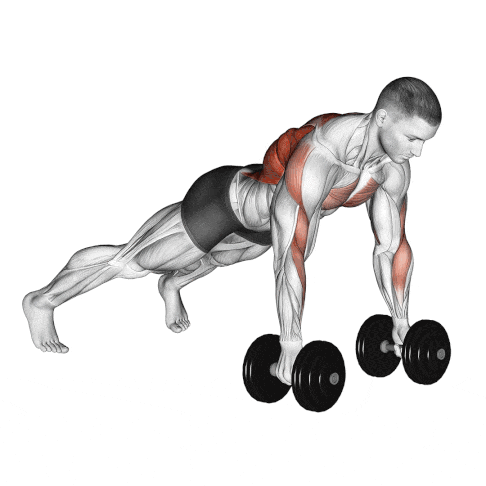
How To Do
- Place two dumbbells on the floor about shoulder-width apart.
- Start in the top position of a push-up position with your hands on the weights.
- Pull your right elbow back, raising the dumbbell toward your chest.
- Keep your right elbow close to your torso, your abs tight, and your hips in one line.
- Hold for one second at the top and return the weight slowly to the starting position to repeat on the other side.
Tips
- Keep your body in a straight line from your shoulders to your ankles.
- Do not jerk the weight up. Row weight in a smooth, controlled motion.
- Make sure you do the same number of repetitions for each arm.
Back Exercises Without Equipment
Opting for bodyweight back exercises allows you to workout anytime, anywhere, without relying on specialized gym equipment.
You can create a versatile back workout routine by combining bodyweight exercises with yoga poses and stretching routines.
12. Superman
Superman is one of the best bodyweight back exercises you can do at home. It strengthens your upper and lower back muscles.
If done regularly, the Superman may help alleviate back pain that is related to weak back muscles.
In addition to strengthening back muscles, it also works on your glutes and your hamstring muscles.
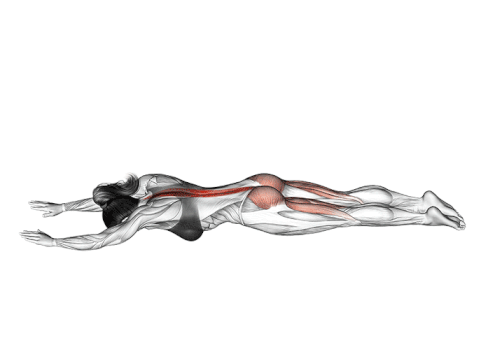
How To Do
- Lie down with your stomach flat on the ground. Extend your arms in front of you, with your palms down.
- Lift your head, raise your arms and chest off the ground as far as possible.
- Bend your legs and lift your thighs off the ground as much as possible. (Try to make a big “U” with your back.)
- At this point, you should feel your back muscles, your glutes, and hamstrings tighten up.
Tips
- Try holding for only five or 10 seconds your first time, and work up to 30 seconds in future workouts.
- Do not hold your breath. Breathe regularly.
13. Good Morning
The Good Morning is a compound movement that primarily targets the muscles of the lower back, hamstrings, and glutes. It involves bending forward at the hips and keeping a neutral spine, like bending forward to say “good morning.”
They also engage the core muscles, including the abdominal muscles and obliques, to provide stability and support during the movement.
It is a great move for improving your back health when done with solid spinal alignment and perfect form. I strongly suggest adding these lower back exercises to your home workout regimen.
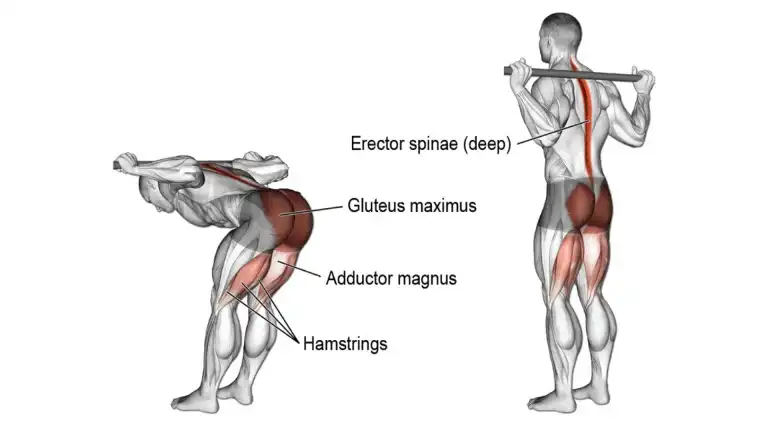
How To Do
- Stand with your feet shoulder-width apart and toes slightly outward.
- Stand with a stick on the back of your shoulders and grasp it at each side.
- You can also perform the exercise with your bodyweight.
- Engage your core, keep your spine neutral, and maintain a slight knee bend.
- Start the exercise by extending your hips backward while maintaining a straight back.
- Continue to lower your torso forward until you feel a stretch in your hamstrings or your torso is parallel to the floor.
- At the bottom position, pause for a moment.
- Exhale as you raise your torso back up to the starting position by extending your hips.
Tips
- Keep your back and neck neutral throughout the exercise.
- It is recommended that the lifter avoid rounding (flexing) or rotation (twisting) at any point during the movement.
- Keep the movement slow, the form strict, and the weight light.
- Complete the desired number of repetitions.
14. Hip Bridge
The hip bridge is a good starter move for your home workout to train butt, hamstring, back muscles and to manage low back pain.
Sitting all day can weaken your glute muscles and shorten your hip flexors, making them feel tight.
But when you practice glute bridges regularly at home, you target your glutes and lower back muscles, which are meant to hold your body upright.
A study has shown that a single-leg bridge with a 135-degree knee bend hits your glutes harder than the standard bridge by reducing hamstring involvement.
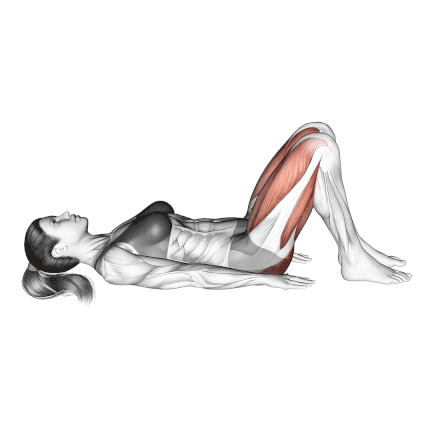
How To Do
- Lie faceup on the floor, with your knees bent and feet flat on the ground.
- Keep your arms at your side with your palms down.
- Lift your hips off the ground until your knees, hips, and shoulders form a straight line.
- Squeeze those glutes hard and keep your abs drawn in so you don’t overextend your back during the exercise.
- Hold your bridged position for a couple of seconds before keeping back down.
Tips
- Do not push with your arms.
- Hold a weight plate on your lap to make the Hip bridge exercise more difficult.
15. Flat Bench Hyperextension
If you’re looking for a way to be more creative with your at-home back workout, why not try flat bench Hyperextension?
It directly hits the erector spinae muscles, to build a strong back.
To make Hyperextensions difficult, hold a plate to your chest or behind your head for additional resistance. If the exercise becomes easy, you can do many reps.
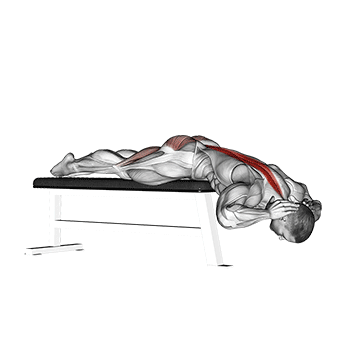
How To Do
- Lie face down on a flat bench with your torso extending off the end.
- Hook your heels under the bench to prevent yourself from falling forward.
- Place your hands on your chest (or behind your neck) and bend down through your waist.
- Return to the start position, but avoid extending beyond the body level.
Tips
- Avoid hyperextension beyond the body level.
- Keep movement always under control, without letting gravity take you down faster.
16. Pull-Up
Pull-ups are compound exercises, which means that they work multiple muscle groups at the same time
They primarily target the muscles of the upper body, specifically the back, shoulders, arms and core muscles.
It is a great exercise for building upper body strength, improving posture, and increasing muscle mass.
The pull-up increases your back’s strength, thickness, and width, specifically your lats. The lats are what influence back width and form the “V” in the upper back.
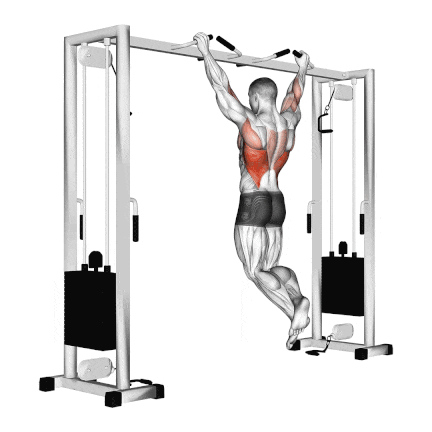
How To Do
- Grip the pull-up bar with your palms facing away from you at shoulder width.
- Engage your core and keep your body straight from your head to your heels.
- Pull your body up towards the bar by flexing your elbows and bringing your chest towards the bar.
- Keep your elbows close to your body as you pull yourself up.
- Once your chin is above the bar, hold for a moment and lower yourself slowly.
Tips
- To decrease bicep involvement, use a thumbless grip.
- Go with the full range of motion and keep the form correct.
Know More: 25 Different Types Of Pull Ups And Chin Ups (Variations)
17. Inverted Row
The inverted row is another name for bodyweight rows. It puts your body horizontally, making it easier to perform. It also works the back and shoulder muscles from a different angle and improves scapular retraction.
But, you can also perform the inverted back row exercise at home by lying under a chair, holding the chair’s sides, and pulling yourself up.

How To Do
- Adjust the height of the chair and bar so that it’s a little higher than arm’s length from the floor.
- Lie under the bar with your legs and body straight.
- Grasp the bar with an overhand grip that’s a little wider than shoulder width.
- Keeping your legs and body straight, exhale as you pull your chest up to the bar.
- Hold for a count of two and squeeze your back muscles.
- Inhale as you lower your body until your arms and shoulders are fully extended. Repeat.
Tips
- Do not allow your butt to sag. Flex your tummy, squeeze your butt cheeks, and keep your body stiff from your head to your toe.
- Do not allow your elbows to flail. Grab the bar with your hands slightly closer together, keeping your elbows at an angle to your body like doing a bench press.
- Make sure you go down completely. Lower your body and ensure the arms are extended, and raise your body until you touch the chest and the bar.
18. Chin Up
Chin-ups also target the upper body, specifically the back muscles such as latissimus dorsi, trapezius, rhomboids and shoulders, and arms.
Whereas a chin-up is an exercise in which the palms face toward the body (overhand or pronated grip) while gripping the bar. This grip targets the biceps more than the back and shoulders.
It is the most effective bodyweight exercise you can do at home, and it can result in significant muscle growth in the back and biceps.
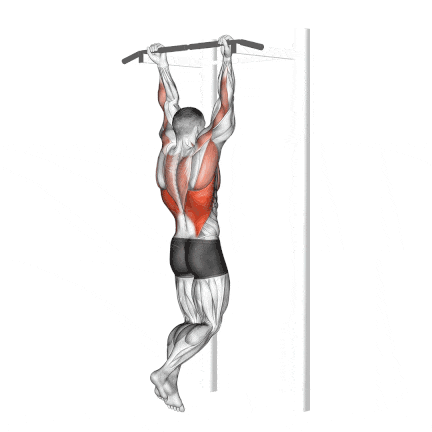
How To Do
- Grab a pull-up bar with an underhand grip (palm facing toward the body), hands shoulder-width apart or slightly narrower.
- Straighten your arms, keep your knees bent and cross your lower legs. It can also be done with a straight leg.
- Retract your shoulder blades and pull your body up until your chin aligns with the bar.
- Pause at the top for one to two seconds with the biceps under maximum tension. Slowly lower to the start position.
Tips
- Don’t get in the habit of doing half reps and chasing numbers.
- Lower to almost full extension of the elbow, but avoid locking out completely.
Back Workout At Home With The Resistance Band
Resistance bands have all sorts of uses. And there are numerous benefits to including resistance band work in your back training:
- Resistance bands are inexpensive whether you buy them individually or as a set.
- When you don’t have a lot of room for a home gym, resistance bands are a great option that stores in very little space.
- Resistance bands offer strength training without the risk of dropping a heavy weight on your foot or crushing your fingers between weight plates.
- They come in multiple resistance levels, usually light, medium, or heavy. You can use any of them as per your fitness level.
19. Single Arm Resistance Bands Row
This is one of the best back exercises that you can do with a band during your back workout.
The primary mover here is the latissimus dorsi. So, that is the main muscle you are targeting.
Moreover, as it is a single-arm movement, your core and lower back will work to stabilize you.

How To Do
- Place the center of a resistance band under your right foot and stand with your feet staggered, left behind right.
- Hold the ends of the band in your right-hand next to your leg and bend forward from the hips.
- Brace your core and drive your right elbow past your back until the band is fully taut.
- Reverse direction and perform the prescribed number of repetitions before switching sides.
Tips
- Concentrate on pulling with your back muscle right behind and below your shoulder (lats).
- Keep your abs pulled in tight at all times, and don’t sag your back or hunch up.
- Pull your shoulder down and back to set and stabilize your shoulder blades.
20. Resistance Bands Bent Over Rows
Resistance band bent-over rows are a popular back exercise that targets the upper back muscles, including the rhomboids, trapezius, and latissimus dorsi. They are a compound exercise that also works your arms and core muscles.
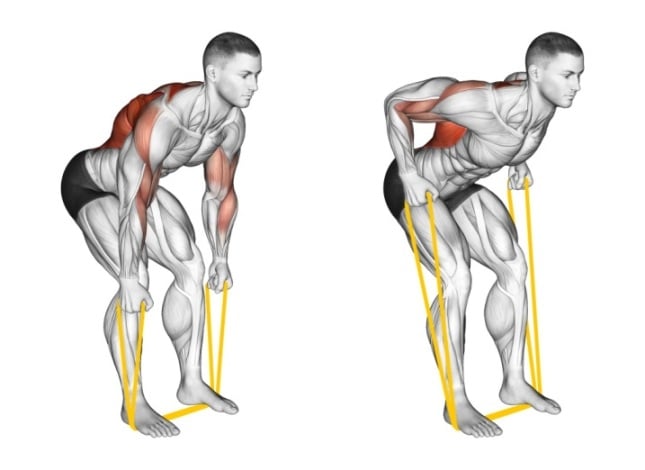
How To Do
- Stand on a resistance band, bending forward slightly, and hold both handles just under your knee.
- Keep your back flat and arms straight.
- Leading with your elbows, pull the handles of the resistance band back, bringing your shoulder blades closer together.
- Hold this contraction and slowly release it to the starting position.
Tips
- Make sure you maintain the high hip hinge as you row. Keep your core engaged.
- Maintain alignment at all times. Protract your shoulder blades at the bottom.
- Hold at peak contraction and then slow negative movement.
21. Seated Row with Resistance Bands
Finally, if you’re looking for one more effective resistance band back exercise, try the Seated band row.
It primarily targets the latissimus dorsi, rhomboids, and rear delts. It will also work your erector spinae, as you need your lower back to stabilize your movement.
Overall, this is a great movement for your mid-back.
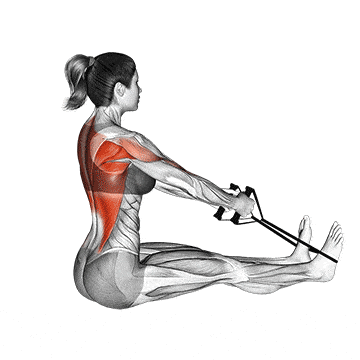
How To Do
- Sit on the floor with your legs extended. Loop the resistance band around the soles of your feet and hold one end in each hand.
- Keeping your posture erect and your lower back slightly arched, slowly pull the handles to your lower abdomen, keeping your elbows close to your sides.
- As the handles touch your body, squeeze your shoulder blades together and reverse direction, slowly returning to the start position.
Tips
- Retract your shoulder blades as you pull the band back.
- Keep your core fully engaged, which means your lower back too! Row towards just above your navel.
- Maintain your legs extended with just a slight bend in the knee and keep your shoulders back.
At Home Back Workout Routine
Training Plan As Per Your Goal
- For muscle endurance: Aim for 3-4 sets of 12-15 reps, with moderate resistance.
- For muscle strength: Aim for 3-5 sets of 6-10 reps, with a heavier amount of resistance.
- For muscle hypertrophy (increased muscle size): Aim for 3-4 sets of 8-12 reps, with a moderate to heavy amount of resistance.
It is always best to start with a lower number of reps and sets, and then gradually increase as your strength improves.
Bodyweight Back Workout Routine
| Exercise | Sets x Reps |
|---|---|
| Pull-Ups | 3 sets x 8-10 reps |
| Inverted Rows | 3 sets x 10-12 reps |
| Superman Hold | 3 sets x 30 seconds |
| Hip Bridge | 3 sets x 10-12 reps |
| Plank Rows | 3 sets x 10-12 reps |
At-Home Back Workout Without Equipment
| Exercise | Sets x Reps |
|---|---|
| Bent-Over Rows | 3 sets x 10-12 reps |
| Renegade Rows | 3 sets x 8-10 reps |
| Single-Arm Dumbbell Row | 3 sets x 10-12 reps per arm |
| Dumbbell Pullovers | 3 sets x 10-12 reps |
| Reverse Flyes | 3 sets x 10-12 reps |
Back Workout Routine With Home Equipment
| Exercise | Equipment | Sets x Reps |
|---|---|---|
| Wide Grip Pull-Ups | Bodyweight | 3 sets x 8-10 reps |
| Bent-Over Rows | Dumbbells | 3 sets x 10-12 reps |
| Resistance Band Lat Pulldowns | Resistance Band | 3 sets x 10-12 reps |
| Superman Hold | Bodyweight | 3 sets x 30 seconds |
| Plank Rows | Dumbbells | 3 sets x 10-12 reps |
FAQs
Can I build a strong back without using weights or equipment?
Yes, it is possible to build a strong back without weights or equipment. Exercises such as push-ups, pull-ups, inverted rows, and plank variations can effectively target and strengthen your back muscles. Also, using resistance bands in your workouts can add challenge and variety.
What are the best back exercises to do at home without equipment?
There are several effective back exercises you can do at home without equipment. Some of the best bodyweight exercises for the back include push-ups,
- Pull-ups
- Inverted rows
- Superman holds
- Plank rows
- Superman
- Good Morning
- Hip Bridge
- Flat Bench Hyperextension
How many times a week should I do back workouts at home?
To get the best results, do back exercises 2-3 times a week. Giving your muscles at least 36-48 hours to rest between workouts helps them recover and grow.
How long does it take to see results from back workouts at home?
The period of time required for you to see results from home workouts can vary based on several variables, such as your initial fitness level, regularity of exercise, food intake, and inherited traits.
Generally, noticeable strength and muscle tone improvements are visible within a few weeks to a couple of months. However, achieving long-term progress and significant changes may take several months of consistent training.
Takeaway
You don’t need gym access to build an impressive physique. Using the home exercises mentioned above, you can hit all areas of your back with lots of variety.
It’s about getting creative and using equipment or exercises you wouldn’t normally use. Furthermore, back training is seriously overlooked when working out at home, so throwing in some more variety is good.
Video On Best Back Exercises To Do At Home

Manish is a NASM-certified fitness and nutrition coach with over 10 years of experience in weight lifting and fat loss fitness coaching. He specializes in gym-based training and has a lot of knowledge about exercise, lifting technique, biomechanics, and more.
Through “Fit Life Regime,” he generously shares the insights he’s gained over a decade in the field. His goal is to equip others with the knowledge to start their own fitness journey.
